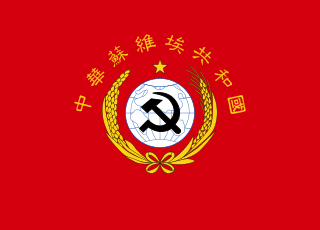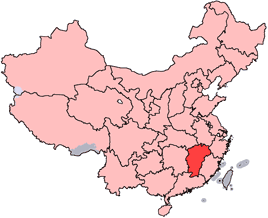
The Chinese Soviet Republic (CSR) was a state within China, proclaimed on 7 November 1931 by Chinese Communist Party (CCP) leaders Mao Zedong and Zhu De in the early stages of the Chinese Civil War. The discontiguous territories of the CSR included 18 provinces and 4 counties under the communists' control. The CSR's government was located in its largest component territory, the Jiangxi Soviet. Due to the importance of the Jiangxi Soviet in the CSR's early history, the name "Jiangxi Soviet" is sometimes used to refer to the CSR as a whole. Other component territories of the CSR included the Northeastern Jiangxi, Hunan-Jiangxi, Hunan-Hubei-Jiangxi, Hunan-Western Hubei, Hunan-Hubei-Sichuan-Guizhou, Eyuwan, Shaanxi-Gansu, Sichuan-Shanxi, and Haifeng-Lufeng Soviets.

Xu Xiangqian was a Marshal of the People's Republic of China (PRC). He was the son of a wealthy landowner, but joined the Kuomintang's (KMT) National Revolutionary Army (NRA), against his parents' wishes, in 1924. When the Chinese Civil War started in 1927, Xu joined the Eyuwan Soviet led by Zhang Guotao; Xu became commander of the Eyuwan-based Fourth Red Army. Zhang and Xu retreated to northern Sichuan after being defeated by a KMT encirclement campaign. Xu politically survived Zhang's defection to the KMT in the late-1930s; he rejoined the Red Army in a less senior position under the leadership of Mao Zedong.

Zhang Guotao, or Chang Kuo-tao, was a founding member of the Chinese Communist Party (CCP) and rival to Mao Zedong. During the 1920s he studied in the Soviet Union and became a key contact with the Comintern, organizing the CCP labor movement in the United Front with the Kuomintang. From 1931 to 1932, after the Party had been driven from the cities, Zhang was placed in charge of the Eyuwan Soviet. When his armies were driven from the region, he joined the Long March but lost a contentious struggle for party leadership to Mao Zedong. Zhang's armies then took a different route from Mao's and were badly beaten by local Muslim Ma clique forces in Gansu. When his depleted forces finally arrived to join Mao in Yan'an, Zhang continued his losing challenge to Mao, and left the party in 1938. Zhang eventually retired to Canada, in 1968. He became a Christian shortly before his death in Scarborough, Ontario, in 1979. His memoirs provide valuable and vivid information on his life and party history.
The history of the People's Liberation Army began in 1927 with the start of the Chinese Civil War and spans to the present, having developed from a peasant guerrilla force into the largest armed force in the world.
Encirclement campaigns, officially called in Chinese Communist historiography as the Agrarian Revolutionary War, were the campaigns launched by forces of the Chinese Nationalist Government against forces of the Chinese Communist Party during the early stage of the Chinese Civil War.

The first encirclement campaignagainst Jiangxi Soviet was a series of battles launched by the Chinese Nationalist Government intended to annihilate the Chinese Red Army, and destroy the Soviet. The communists later responded with the first counter-encirclement campaign at Central Soviet, also called by the communists as the first counter-encirclement campaign at Central Revolutionary Base, in which the Red Army successfully defended the Soviet Zone in the southern Jiangxi province against Nationalist attacks from November 1930 to January 3, 1931.

The fourth encirclement campaign against the Jiangxi Soviet was the fourth campaign launched by the Chinese Nationalist Government in hope to destroy the Red Army in Jiangxi. The Nationalist headquarters in the provincial border of Jiangxi-Guangdong-Fujian organized nearly 400,000 men, and prepared for another major encirclement on the Chinese Soviet Republic. As a response, the Jiangxi Soviet launched the fourth counter-encirclement campaign at the Central Soviet, also called as the fourth counter-encirclement campaign at the Central Revolutionary Base. Although the Red Army achieved victory once again, their counter encirclement was not as successful as the previous ones this time, and the Red Army elsewhere suffered considerable loss when many other Communist bases were lost, including two major ones.

The encirclement campaign against the Hunan–Western Hubei Soviet was an encirclement campaign launched by the Chinese Nationalist Government that was intended to destroy the communist Hunan–Western Hubei Soviet and its Chinese Red Army in the local region. The Communists' responded by launching the Counter-encirclement campaign at Hunan–Western Hubei Soviet, also called by the communists as the Counter-encirclement campaign at Hunan–Western Hubei Revolutionary Base, in which the Nationalist force defeated the local Chinese Red Army and overran the communist base in the southern Hubei and Hunan provinces from November 1930 to January 1931. Since the bulk of the fighting was fought at the second stage of the campaign, concentrated at the heart of the communist base, the Honghu region of Jingzhou, the campaign is therefore also frequently referred as the Fourth encirclement campaign against Honghu Soviet and the Fourth Counter-encirclement campaign at Honghu Revolutionary Base by the communists, or Fourth Counter-encirclement campaign at Honghu Soviet for short.
The first encirclement campaign against the Eyuwan Soviet was an encirclement campaign launched by the Chinese Nationalist Government against the Eyuwan Soviet, a Communist base located in the border region between Hubei, Henan, and Anhui provinces. The Fourth Red Army responded with its second counter-encirclement campaign and successfully defended the soviet. The Nationalist attacks lasted from November 1930 to 9 March 1931.

The first encirclement campaign against the Honghu Soviet was an encirclement campaign launched by the Chinese Nationalist Government that was intended to destroy the Communist Honghu Soviet and its Chinese Red Army. The Red Army successfully defended their soviet republic against the Nationalist attacks from early December 1930 to the end of January 1931.
The third encirclement campaign against the Eyuwan Soviet was an encirclement campaign launched by the Chinese Nationalist Government against the Communist base in the Hubei–Henan–Anhui border region, the Eyuwan Soviet. The Fourth Red Army responded with its third counter-encirclement campaign, which successfully defended the soviet. The Nationalist attacks lasted from November 1931 to 17 June 1932.

The third encirclement campaign against the Honghu Soviet was an encirclement campaign launched by the Chinese Nationalist Government that was intended to destroy the communist Honghu Soviet and its Chinese Red Army in the local region. The Red Army successfully defended their soviet republic against the Nationalist attacks from early September 1931 to 30 May 1932.
The fourth encirclement campaign against the Eyuwan Soviet was an encirclement campaign launched by the Chinese Nationalist Government against the Communist base in the border region between Hubei, Henan, and Anhui provinces, the Eyuwan Soviet. Although the Fourth Red Army responded with its fourth counter-encirclement campaign, the Nationalists were ultimately successful and overran the soviet area by early October 1932.
The fifth encirclement campaign against the Eyuwan Soviet was an encirclement campaign launched by the Chinese Nationalist Government against the Communist base in the Hubei–Henan–Anhui border region, the Eyuwan Soviet. It was met by the Twenty-fifth Red Army's fifth counter-encirclement campaign. As with the fourth campaign, this campaign ended in a Nationalist victory and the Twenty-fifth Red Army decided in mid-November 1934 to abandon the soviet area and head westwards, joining the Long March.

The Chinese Red Army, formally the Chinese Workers' and Peasants' Red Army or just the Red Army, was the military wing of the Chinese Communist Party from 1928 to 1937. It was formed when Communist elements of the National Revolutionary Army splintered and mutinied in the Nanchang Uprising. The Red Army was reincorporated into the National Revolutionary Army as part of the Second United Front with the Kuomintang to fight against the Japanese during the Second Sino-Japanese War of 1937–1945. In the later stages of the Chinese Civil War they splintered off once again and renamed the People's Liberation Army.
Events in the year 1931 in China.

Xia Douyin (1885–1951) was a Republic of China National Revolutionary Army general. He was born in Macheng, Hubei. Originally a member of the Qing Dynasty New Army, he participated in the Xinhai Revolution of 1911. In 1917, he joined the Constitutional Protection Movement and opposed local warlord Wang Zhanyuan. Defeated by Wang's forces, he fled to Changsha and enlisted the help of allies in Hunan against Wang. After suffering another defeat in 1919, he fled to the border region of Hunan and Jiangxi Provinces. In 1926, he was brought by Tang Shengzhi into the National Revolutionary Army and participated in the Northern Expedition as a divisional commander. On May 17, 1927, Xia led Kuomintang forces loyal to Chiang Kai-shek from Yichang against the forces of Ye Ting in Wuhan. After his victory, he notoriously took personal pleasure in mutilating the corpses of female revolutionaries he had killed. Chiang promoted Xia to army commander and he fought in the Central Plains War of 1930. Xia was then tasked with suppressing the Eyuwan Soviet in the border region between Hubei, Henan, and Anhui provinces. He ordered the massacre of thousands of civilians but was unable to stop the Communists' expansion. In 1932, Xia was promoted to full general and made governor of Hubei, although Zhang Qun actually acted in his place. From July to September 1932, Chiang Kai-shek ordered 300,000 troops of the National Revolutionary Army to surround and suppress the Eyuwan Soviet in the Fourth Encirclement Campaign. Xia directed a scorched earth campaign, killing all men found in the Soviet areas, burning all buildings, and seizing or destroying all crops. He was ultimately successful and the main Communist Red Army was forced to retreat westwards. During the Second Sino-Japanese War, Xia fled to Chengdu after Hubei was occupied by the invading Imperial Japanese Army. In 1945, he retired from the military. Although he attempted to welcome the Chinese Communist Party (CCP) takeover of the mainland, the CCP rebuffed him and he fled to Hong Kong, where he died.
The Battle of Shuangqiaozhen was fought from March 6 to March 12, 1931, between the 34th Division of the Army of the Kuomintang Nationalist Government and the Fourth Red Army of the Chinese Communist Party. It took place during the second encirclement campaign against the Eyuwan Soviet. The commander of the 34th Division, Major General Yue was captured by the communists. In August 1932, Yue was executed by firing squad on the orders of Zhang Guotao and posthumously promoted to full general.
The Eyuwan Soviet was a short-lived soviet government established in March 1930 by the Chinese Communist Party in the Dabie Mountains border region between Hubei, Henan, and Anhui provinces. At its height in 1931 and early 1932, the Eyuwan Soviet was the second-largest Chinese Soviet after the Central Soviet in Jiangxi. It improved the rights of women and redistributed land to poor and landless peasants. It was famously led by Zhang Guotao, a rival of Mao Zedong, who attempted to consolidate his control over Eyuwan with a series of purges. The Fourth Nationalist Encirclement Campaign defeated Eyuwan's Fourth Red Army in late 1932 and forced it to retreat westwards towards Sichuan and Shaanxi. The Soviet government ceased to function and the Communists retreated into the mountains. Despite several extermination campaigns intended to flush them out, the region remained a hotbed of Communist guerrilla activity until a truce was established in the Chinese Civil War.
The following is a topical outline of English Wikipedia articles about the history of the Chinese Civil War (1912–1949)







